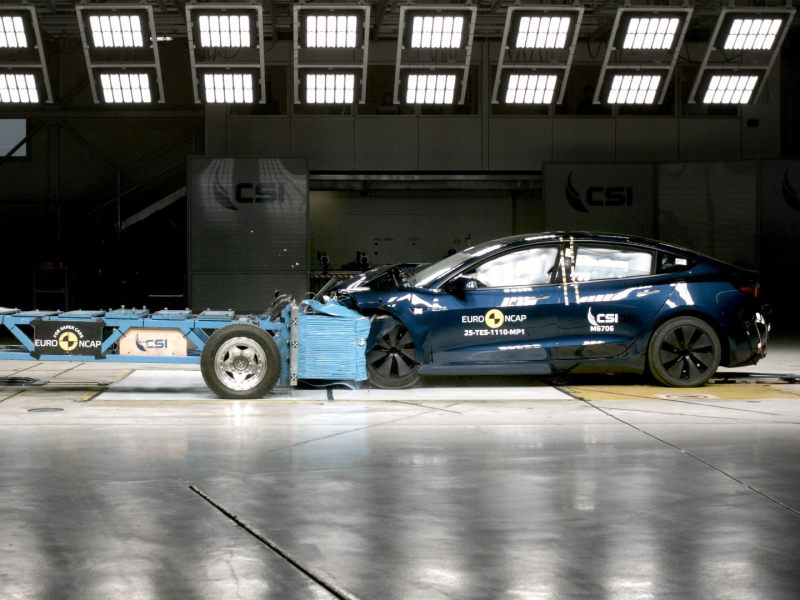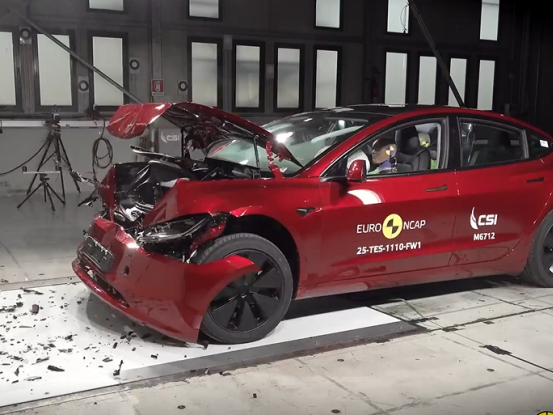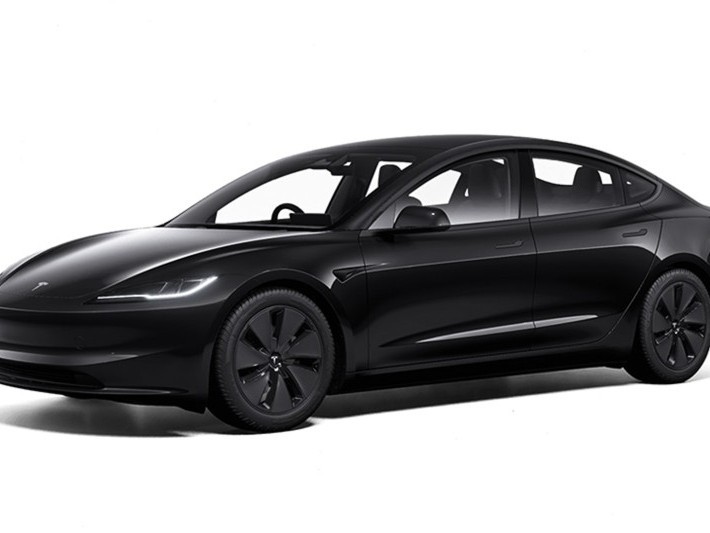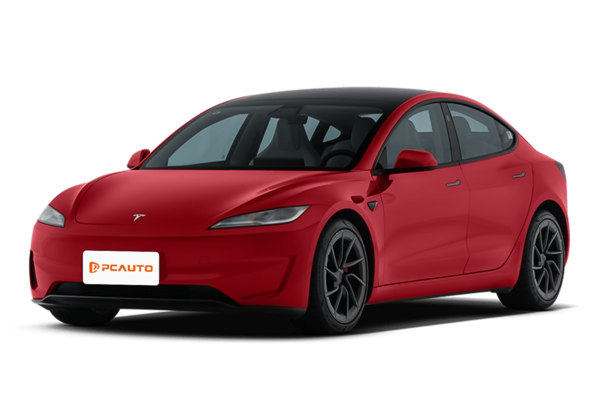Q
How Heavy Does Tesla Model 3 Weight? Check Here to Know
The weight of the Tesla Model 3 varies depending on the vehicle configuration. The curb weight of the Standard Range Rear-Wheel Drive version is approximately 1,611 kilograms, while that of the Performance All-Wheel Drive version is close to 1,847 kilograms. This is mainly due to the dual-motor setup and the larger battery pack. For Malaysian consumers, understanding the vehicle's weight is quite helpful for daily use. For example, the weight can affect the range performance and handling experience. A lighter body is more agile in city driving, while a heavier version offers better stability at high speeds.
It's worth mentioning that the Model 3 features a mixed body structure of aluminum alloy and high - strength steel. This design reduces the weight while ensuring safety, and it's also commonly seen in other high - end electric vehicle brands. When driving on slippery roads in Malaysia's rainy climate, a heavier electric vehicle can actually provide better tire grip. However, owners also need to be aware of the subtle impact of the battery weight on the braking distance. It is recommended to maintain a safe following distance.
Special Disclaimer: This content is published by users and does not represent the views or position of PCauto.
Related Q&A
Q
What Segment is Tesla Model 3?
The Tesla Model 3 falls into the D-segment category (also known as the "mid-size car" or "Executive Car" niche). This segment typically includes mid- to high-end models with a body length of around 4.6 to 4.9 meters and a wheelbase of 2.7 to 2.9 meters. Its competitors encompass traditional luxury brand models like the BMW 3 Series and the Mercedes-Benz C-Class.
In the Malaysian market, the Model 3 has become a key choice for local consumers to access high - end electric vehicles, thanks to its advantages in electrification technology (such as a range of up to 491 kilometers under the WLTP standard on a single charge) and intelligent features (like Autopilot assisted driving). Notably, the Malaysian government offers preferential policies such as exemption from import duties for electric vehicles, making the Model 3 more price - competitive locally.
The D - segment cars, with their moderate body size (for example, the Model 3 is 4,720mm long), combine flexibility and space practicality on Malaysian city roads, making them particularly suitable for congested urban environments like Kuala Lumpur. Other electric options in the same segment include the BYD Seal and the Hyundai Ioniq 6. However, the Model 3 still maintains a significant edge, thanks to Tesla's well - established charging network (12 Supercharger stations have been deployed across Malaysia).
Q
What is the Reslae Value of Tesla Model 3?
The Tesla Model 3 has a relatively high second - hand resale value in Malaysia. This is mainly due to its brand influence, the maturity of electric vehicle technology, and low maintenance costs. According to market observations, the Model 3 can still retain about 60 - 70% of its residual value after three years of use, which is better than many fuel - powered vehicles in the same class. This is related to its long battery life, continuous software updates, and the improvement of charging infrastructure.
For Malaysian consumers, the tax - exemption policy for electric vehicles further reduces the cost of purchasing a car, indirectly increasing the demand in the second - hand market. In addition, Tesla's global unified pricing strategy reduces price fluctuations, making the second - hand car prices more stable.
If you're considering buying a Model 3, it is recommended that you pay attention to the battery health and warranty period, as these factors can significantly affect the resale value. Meanwhile, the gradually expanding charging network in Malaysia also makes the use of electric vehicles more convenient, which will help maintain its second - hand market performance in the long run.
Q
What is the PCD Size of Tesla Model 3?
The PCD (Pitch Circle Diameter) of the Tesla Model 3 is 5x114.3 mm. This means that its wheels have 5 bolt holes, evenly distributed on a circle with a diameter of 114.3 mm. This is a common specification for many modern cars, especially widely used in Japanese and some European models. For Malaysian car owners, it's very important to know the PCD size because it's a key parameter when replacing wheels or upgrading the braking system, ensuring that the new wheels match the original vehicle perfectly. Additionally, the PCD size also affects the vehicle's handling and safety. An incorrect PCD may lead to the wheels not being installed properly or vibrations during driving.
The wheels of the Tesla Model 3 are also compatible with wheels having a center bore diameter of 64.1 mm, and the bolt thread specification is M14x1.5. These details need to be noted when purchasing modified wheels. Since the climate in Malaysia is rainy and humid, it is recommended that car owners choose high - quality wheels and regularly check the bolt tightening to ensure driving safety.
Q
Does Tesla Model 3 Support Apple Carplay?
Currently, the Tesla Model 3 doesn't support the Apple CarPlay feature. This is mainly because Tesla adheres to using its self - developed Infotainment system. This system integrates functions such as navigation, entertainment, and vehicle control, aiming to offer an integrated user experience. Although Apple CarPlay is a standard or optional feature in many other brands' models, Tesla owners can achieve similar functions through its built - in streaming services, Bluetooth connection, or the Tesla mobile app.
For users in Malaysia, Tesla's local services are gradually being improved. For example, it supports local maps and voice commands. So, even without Apple CarPlay, daily use remains convenient. If you have high requirements for in - vehicle connectivity functions, you can look into some models from other brands like BMW, Mercedes - Benz, or the local brand Proton. These models usually offer Apple CarPlay support. However, Tesla's unique advantage lies in its highly integrated system and OTA update capability, which can continuously bring new features to users.
Q
What is the Tyre Brand of Tesla Model 3?
The common original - equipment tire brands for the Tesla Model 3 in the Malaysian market include Michelin, Bridgestone, and Goodyear. The specific configurations may vary depending on the vehicle model version or production batch. For example, the high - performance version may be paired with tires like Michelin Pilot Sport 4S, which focus on grip. The selection of these international brands is to balance the instantaneous torque requirements unique to electric vehicles, low - noise performance, and range optimization. In particular, Michelin's noise - reduction technology can effectively offset the road noise that becomes more noticeable due to the lack of engine noise in electric vehicles.
It's worth noting that Malaysia has a tropical climate with frequent rainfall. Car owners can pay attention to the wet - road performance indicators of tires (such as the AA traction rating in the UTQG grade). When replacing tires, they can also consider the commonly seen Continental from Germany or locally - assembled Japanese brands like Yokohama, which also have formulations suitable for high - temperature and rainy road conditions. Tesla service centers usually recommend suitable replacement tires based on the road conditions in Malaysia. It is recommended that car owners regularly check the tire pressure to ensure it is within the numerical range required for electric vehicles, which is particularly important for maintaining the driving range.
Q
Is Tesla Model 3 a Good Car? Learn the Pros and Cons Here
As a pure - electric sedan, the Tesla Model 3 has a certain appeal in the Malaysian market. Its advantages include excellent acceleration performance, advanced autonomous driving assistance features, and relatively low daily usage costs. In particular, the electricity cost is more economical compared to that of fuel - powered vehicles, making it suitable for urban commuting in Malaysia. Additionally, the Model 3's high - tech interior design and OTA remote upgrade function also provide users with a convenient experience.
However, its drawbacks are also worth noting. For instance, given that the charging infrastructure in Malaysia is not fully popularized, long - distance travel may encounter the problem of inconvenient charging. Meanwhile, the relatively high initial purchase price and the later battery replacement cost may also make some consumers hesitate.
For Malaysian users, if their daily commuting distance is short and there are charging facilities at home or in the workplace, the Model 3 is a good choice. But if they often need to drive long - distance, they may need to plan the charging route more carefully.
Overall, the Model 3 stands out in terms of environmental protection and technology. However, before making an actual purchase, it is necessary to comprehensively consider personal vehicle - using needs and budget.
Q
What is the Width of Tesla Model 3?
The body width of the Tesla Model 3 is 1,848 millimeters (excluding mirrors). This dimension performs excellently in the urban driving environment in Malaysia. It's suitable for maneuvering through narrow streets while still offering a spacious interior. The Model 3's streamlined design not only optimizes the drag coefficient to improve the range but also incorporates an advanced layout of cameras and sensors to support the Autopilot intelligent driving function.
For Malaysian consumers, the width of the Model 3 is similar to that of common mid - sized Japanese or European sedans in the local market. However, its electric platform structure allows for higher utilization of interior space, especially in the rear legroom. Notably, since electric vehicles don't require the traditional transmission structure, the central floor is completely flat, which further enhances the seating comfort.
Against the backdrop of the increasing popularity of charging facilities in Malaysia, the Model 3's compact size and efficient energy consumption make it an ideal choice for urban commuting. Meanwhile, its high - tech interior and OTA remote upgrade function also meet the preferences of the local young consumer group for smart cars.
Q
What is the Road Tax Price of Tesla Model 3? How to Calculate?
In Malaysia, the road tax price for the Tesla Model 3 is calculated based on the electric vehicle's motor power (kW), rather than the engine capacity of traditional fuel-powered vehicles. This is a special policy implemented by the Malaysian government for electric vehicles. According to the current regulations, the formula for calculating the road tax for electric vehicles is: a charge of RM20 per kilowatt (kW). For example, the rear - wheel - drive version of the Tesla Model 3 has a motor power of 208kW, so its road tax would be 208 x RM20 = RM4,160. The high - performance all - wheel - drive version has a motor power of 377kW, and its road tax would be 377 x RM20 = RM7,540.
It should be noted that electric vehicles in Malaysia enjoy road tax exemption benefits. As of the end of 2023, the government has temporarily waived the road tax for electric vehicles. Therefore, currently, Tesla Model 3 owners do not need to pay road tax. However, future policies may be adjusted, and it is recommended to follow the latest announcements from the Malaysian Ministry of Transport.
In addition, electric vehicles in Malaysia also enjoy preferential policies such as import tax and consumption tax exemptions. These policies aim to encourage more people to choose environmentally friendly vehicles and reduce carbon emissions.
If you are considering buying a Tesla Model 3, apart from the road tax, you can also learn about practical information such as the distribution of charging facilities and the installation of home charging piles to better plan your vehicle - using life.
Q
What is the Second Hand Price of Tesla Model 3? Check Used Price Here
In Malaysia, the price of used Tesla Model 3s is influenced by factors such as the vehicle's age, mileage, configuration, and condition. Currently, the price range is approximately between 120,000 and 180,000 Malaysian ringgit, depending on the specific circumstances of the vehicle. For example, a 2020 standard - range version with low mileage might cost around 120,000 ringgit, while a well - conditioned 2022 long - range or performance version could reach about 180,000 ringgit.
When buying a used electric vehicle, it's advisable to check the battery's health status and the remaining warranty period. Tesla's official battery warranty usually lasts for 8 years or 160,000 kilometers, which is an important guarantee for second - hand buyers. Moreover, the Malaysian government offers tax incentives for electric vehicles, such as exemptions on import and sales taxes, which indirectly enhances the cost - effectiveness of used Teslas.
If you're considering buying a used Model 3, it's recommended to go through official certified channels or reputable used - car dealers. This ensures that the vehicle has undergone professional inspections and comes with a complete warranty service. Plus, you'll enjoy a more transparent transaction process.
Q
What is the Tyre Pressure of Tesla Model 3?
The recommended standard tire pressure for the Tesla Model 3 is 2.9 to 3.1 bar (42 to 45 psi). The specific values may vary slightly depending on the vehicle configuration or tire model. Owners can find the official recommended values on the label of the door frame or in the vehicle manual. In Malaysia, where the climate is hot, the tire pressure will increase slightly as the temperature rises. It is recommended to check the tire pressure at least once a month, especially before long - distance driving, to ensure driving safety and energy - efficiency. Using a Tire Pressure Monitoring System (TPMS) can monitor the tire pressure status in real - time. If the tire pressure is too low, it will increase tire wear and energy consumption; if it is too high, it will affect the grip and comfort. It's worth noting that for electric vehicles, due to the special distribution of battery weight, maintaining the correct tire pressure is particularly important for the range performance. At the same time, it is recommended to choose the original - certified tires to meet the vehicle's performance requirements.
Latest Q&A
Q
Does the 2020 Honda Accord have transmission problems?
The 2020 Honda Accord has performed well overall in the Malaysian market. Its CVT and 10-speed automatic transmissions (depending on the trim) are technically mature, with most owners reporting smooth and reliable operation. However, some isolated cases may experience slight low-speed hesitation or delayed shifting, which are common characteristics of CVT transmissions rather than malfunctions. Honda Malaysia has not issued any large scale recalls or technical bulletins for this model regarding the transmission. It is recommended to check the transmission fluid condition during regular maintenance to ensure optimal performance. For consumers considering a used 2020 Accord, it is advisable to conduct a pre-purchase inspection through an authorized Honda service center, focusing on reading transmission fault codes and historical data. Notably, while CVT transmissions are known for their fuel efficiency, driving style can affect their lifespan. It is recommended to avoid frequent hard acceleration to extend component longevity. If unusual shifting vibrations or warning lights appear, contact an authorized Honda service point promptly for professional diagnosis. All Honda service centers in Malaysia are equipped with dedicated diagnostic equipment to quickly identify issues.
Q
What year to avoid Accord?
In Malaysia, the Honda Accord is a popular mid-size sedan, but certain model years can have some common issues that buyers should watch out for when shopping around. Based on owner feedback and expert reviews, some 2013 and 2014 Accord models had problems with transmission jerking and electronic system glitches, especially the CVT-equipped versions, which might develop rough shifting after long-term use. Additionally, owners of 2008 to 2010 Accords have reported higher fuel consumption and suspension noises. While these don't affect driving safety, they could increase long-term maintenance costs. If you're buying a used Accord, it's better to prioritize models from 2015 onwards—they saw significant improvements in reliability and fuel efficiency. Malaysia's hot and humid climate means you should also pay extra attention to the car's air conditioning system and electrical wiring when checking it out. Regular maintenance can really help extend the vehicle's lifespan. If your budget allows, the new Accord's hybrid system performs better in terms of fuel savings and driving experience, making it a good fit for buyers who value eco-friendliness and comfort.
Q
Which is better, the 2019 or the 2020 Honda Accord?
Both the 2019 and 2020 Honda Accord are really popular mid-size sedans in the Malaysian market. They don't differ much in core specs, but the 2020 model gets some nice detail upgrades. On the outside, the 2020 Accord has subtle tweaks to the front grille and wheel designs, giving it a more modern look, plus there are new exterior color options. Inside, the 2020 version comes standard with an 8-inch infotainment screen and an upgraded Honda Sensing safety suite, including more responsive adaptive cruise control and lane-keeping assist – features that were optional on some 2019 trims. Under the hood, both models offer the 1.5T turbo engine or the 2.0L hybrid system, with similar fuel economy, but the 2020's CVT transmission feels smoother in its tuning. For Malaysian buyers, if your budget allows, the 2020's upgraded features are worth considering, especially the improved safety tech which is really handy for daily driving. It's worth noting that 2019 models might offer better value in the used car market, but make sure to check the service records carefully if you go that route. The Honda Accord is known in Malaysia for its reliability and low maintenance costs, so both model years are solid picks – it just comes down to your budget and how much you want the newer features.
Q
Which year of Accord is most reliable?
In the Malaysian market, the Honda Accord is a favorite among consumers for its reliability and durability, especially the ninth-generation models produced from 2013 to 2017, which deliver an outstanding overall performance. This generation comes with an optimized 2.4-liter naturally aspirated engine or a 3.5-liter V6, offering smooth power delivery and decent fuel efficiency. It's paired with either a CVT or 6-speed automatic transmission—both mature technologies with low failure rates. Additionally, the ninth-gen Accord features a solid body structure and a well-tuned chassis that balances comfort and handling, making it suitable for Malaysia's diverse road conditions. If your budget is tight, the eighth-generation Accord (2008–2012) is also a solid pick, though keep in mind that some high-mileage used units may have issues like worn steering gears or suspension bushings. When shopping for a used Accord, prioritize checking regular maintenance records and pay close attention to the upkeep of critical components like transmission fluid and timing chains. As for hybrid versions, the i-MMD system in the tenth-generation Accord (2018 onwards) performs reliably, but battery life will gradually decline with years of use—professional testing is recommended before purchase. Overall, the Accord ranks among the most reliable in its class, and with proper maintenance, it can stay in great shape for the long haul.
Q
How long will a 2020 Accord last?
The 2020 Honda Accord can typically clock 200,000 to 300,000 kilometers or more with regular maintenance and proper use. Its actual lifespan depends on the owner's driving habits, how often it's serviced, as well as road conditions and climate in Malaysia. Under the hood, it’s packing Honda’s reliable Earth Dreams engine paired with a CVT transmission—proven tech with solid durability. Sticking to regular oil changes, transmission fluid replacements, and maintaining key components like the brakes and suspension can seriously extend its road life. Malaysia’s hot and humid weather might take a toll on rubber parts (think belts and seals) and the battery, so it’s a good idea to check these every six months and opt for original or high-quality replacement parts. Also, the Accord holds its value pretty well in Malaysia’s used car market, and a solid service history can bump up its resale price even more. For long-term ownership, follow the official maintenance manual and head to authorized Honda service centers for upkeep—you’ll get professional technical support and genuine parts that way. If you’re planning to keep it for the long haul, consider periodic deep maintenance too, like fuel system cleaning and coolant replacement, to keep the car in top shape.
View MoreRelated News

Tesla launches Model Y Standard in the US, removes glass roof
MichaelOct 9, 2025

Tesla Model 3 scored the highest in 2025 Euro NCAP, becoming the safest new car in Europe
AshleyJul 8, 2025

2025 Tesla Model 3: Euro NCAP 5-Star Safety Champion
LienMay 23, 2025

Tank vs Tesla: The Underbody Wins
WilliamMay 12, 2025

Want a Comfortable Long-Range Ride? Tesla Model 3 Delivers!
WilliamApr 17, 2025
View More















Pros
Cons